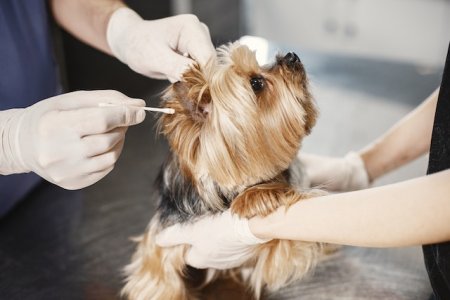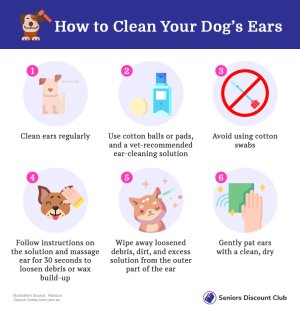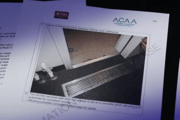Is your dog's health at risk? Here’s why you should take good care of their ears
By
Seia Ibanez
- Replies 0
If you are a dog owner, then you know it’s your job to look after your furry friend, which means ensuring they live a comfortable and fulfilling life. This includes taking care of the little things.
Their ears, in particular, their inner ears, which many people often overlook when pampering their pooch.
Neglecting proper ear care for your dog could lead to ear problems and infections, and maybe even long-term consequences. Who'd want their beloved pet to suffer through that if you can avoid and prevent it?
According to Veterinarian Dr Katrina Warren, the ear-specific issues that have been observed among dogs have a lot to do with their physiology.
'A dog's ear canal is a long, narrow passage extending a considerable distance before reaching the eardrum,' Dr Warren explained.
'Due to its curvy design, a dog's inner ears provide an ideal environment for parasites, bacteria, and yeast to thrive.'
There are also some breeds that are particularly vulnerable to ear problems due to genetics or lifestyle. Breeds with long, floppy ears, such as Cocker Spaniels, are especially prone to ear infections due to a lack of natural airflow; while active water-loving dogs—such as Labrador Retrievers—need more frequent cleaning to prevent moisture-related issues from forming.
Fortunately, it isn't hard to determine when your dog may have a problem. There are several signs and symptoms you should look out for when inspecting your pup's ears for possible issues.
The most common red flags to look for include:
Cleaning your dog’s early regularly helps remove any excess wax, dirt, and debris. It also prevents the build-up of harmful microorganisms that can cause painful infections.
However, while you may know the general procedure, there are still steps one must take to ensure the cleaning process is done safely and properly.
When cleaning your pup's ears, make sure you use cotton balls or pads and a vet-recommended, dog-specific gentle ear-cleaning solution.
‘Never use cotton swabs,’ Dr Warren explained. They may cause damage to their ear canal if pushed too far inside.
Even for us dog-owners, doctors highly discourage the use of cotton swabs for our ears. You can check this story we made to know why we shouldn’t be using cotton swabs within our ear canal.
Follow the instructions provided with the ear cleaning solution and massage the base of the ear for approximately 30 seconds to loosen any debris or wax build-up.
‘Wipe away the loosened debris, dirt, and excess solution from the outer part of the ear. Be gentle and avoid pushing debris further into the ear canal,’ the vet continued.
When you're finished, gently pat the ears dry using a clean, dry cloth.
Our furry friends may not be able to tell us when they may be in pain, so it's important to be aware of any signs or symptoms that indicate potential ear issues.

Members, if you notice any signs of irritation, pain, offensive odour, or discharge from the ear canal, you should seek immediate veterinary attention.
Do you own dogs or other pets? We’d love to see some photos! Share them in the comments below!
Their ears, in particular, their inner ears, which many people often overlook when pampering their pooch.
Neglecting proper ear care for your dog could lead to ear problems and infections, and maybe even long-term consequences. Who'd want their beloved pet to suffer through that if you can avoid and prevent it?
According to Veterinarian Dr Katrina Warren, the ear-specific issues that have been observed among dogs have a lot to do with their physiology.
'A dog's ear canal is a long, narrow passage extending a considerable distance before reaching the eardrum,' Dr Warren explained.
'Due to its curvy design, a dog's inner ears provide an ideal environment for parasites, bacteria, and yeast to thrive.'
There are also some breeds that are particularly vulnerable to ear problems due to genetics or lifestyle. Breeds with long, floppy ears, such as Cocker Spaniels, are especially prone to ear infections due to a lack of natural airflow; while active water-loving dogs—such as Labrador Retrievers—need more frequent cleaning to prevent moisture-related issues from forming.
Fortunately, it isn't hard to determine when your dog may have a problem. There are several signs and symptoms you should look out for when inspecting your pup's ears for possible issues.
The most common red flags to look for include:
- Frequent head shaking and ear scratching
- Sensitivity to touch in the ear area
- Discharge and unpleasant odours
- Blood blisters on the ear flap
- Swelling and redness of the skin
- Head tilt
Cleaning your dog’s early regularly helps remove any excess wax, dirt, and debris. It also prevents the build-up of harmful microorganisms that can cause painful infections.
However, while you may know the general procedure, there are still steps one must take to ensure the cleaning process is done safely and properly.
When cleaning your pup's ears, make sure you use cotton balls or pads and a vet-recommended, dog-specific gentle ear-cleaning solution.
‘Never use cotton swabs,’ Dr Warren explained. They may cause damage to their ear canal if pushed too far inside.
Even for us dog-owners, doctors highly discourage the use of cotton swabs for our ears. You can check this story we made to know why we shouldn’t be using cotton swabs within our ear canal.
Follow the instructions provided with the ear cleaning solution and massage the base of the ear for approximately 30 seconds to loosen any debris or wax build-up.
‘Wipe away the loosened debris, dirt, and excess solution from the outer part of the ear. Be gentle and avoid pushing debris further into the ear canal,’ the vet continued.
When you're finished, gently pat the ears dry using a clean, dry cloth.
Our furry friends may not be able to tell us when they may be in pain, so it's important to be aware of any signs or symptoms that indicate potential ear issues.
Key Takeaways
- Ear problems are among dogs' most common issues, and neglecting proper ear care can lead to discomfort, infections, and sometimes long-term complications.
- Certain breeds with long, floppy ears are more prone to ear infections due to reduced airflow.
- Common signs of potential ear issues include frequent head shaking and ear scratching, sensitivity to touch in the ear area, discharge and unpleasant odours, among others.
- Regular cleaning, done with cotton balls or pads and a dog-specific gentle ear-cleaning solution, helps remove excess wax, dirt, and debris, preventing the build-up of harmful microorganisms.
Members, if you notice any signs of irritation, pain, offensive odour, or discharge from the ear canal, you should seek immediate veterinary attention.
Do you own dogs or other pets? We’d love to see some photos! Share them in the comments below!









